Let’s give them some ‘leafy’ curry
View(s):In this the fourth in our series on edible leafy greens, today we feature leaves that can be used for ‘curries’
By Dr. Nirmala M. Pieris
Curry usually refers to a dish with gravy flavoured with curry powder. The composition of the curry powder which is a mixture of spices and herbs can vary. In Sri Lanka a curry is cooked in coconut milk and served with rice. Leafy green curries are almost always prepared with lentils or jak seeds or potatoes, so as to give the curry a richer texture and taste.
To make the curry, mix the lentils, cubed potatoes or jak seeds in a saucepan together with some chopped onion, garlic, green chillies, curry leaves, raw curry powder, turmeric powder and if required some chilli powder and cook in water or dilute coconut milk (diya kiri in Sinhalese) until soft. Bring to simmer, add some thick coconut milk (miti kiri), salt and the roughly chopped up leaves, mix well and cook until tender. Do not overcook to keep curry nutritious and attractive.
If preferred, the mixture can be tempered with onions, mustard seeds and maldive fish at any stage of the cooking process to give it an additional flavour. Always use young leaves (dalu in Sinhalese) as they provide the most flavour. Mature leaves are less flavourful and palatable and tend to be fibrous and stringy.
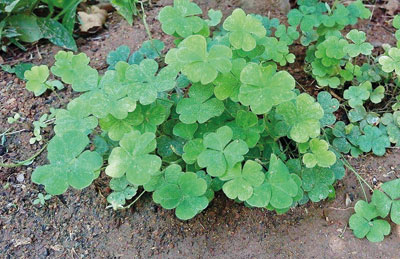
Ambul ambiliya
Ambul ambiliya,Oxalis corniculata in the family Oxalidaceae is a creeping weed also called wood sorel with heart shaped leaves that you will commonly find in your garden in clumps especially during the rainy season. Leaflets are a good source of calcium, iron, vitamin C, beta carotene and also contain oxalic acid that gives it a sharp flavour. The leaves should only be eaten in small amounts since oxalic acid can bind up the body’s supply of calcium. However the oxalic acid is reduced when the leaves are cooked. Ambul ambiliya, is good for indigestion, diarrhoea and for insomnia and inducing sleep.
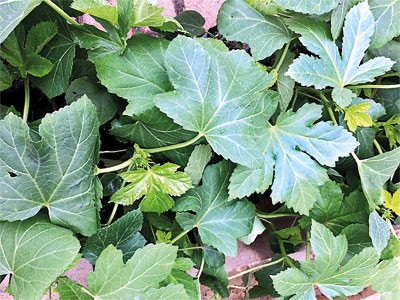 Bandakka
Bandakka
Bandakka, also known as Okra or ladies finger, Abelmoschus esculentus in the family Malvaceae have 3 to 7 lobed leaves covered on both sides with a thin layer of fine bristles. The taste and texture of the tender leaves resemble that of spinach. Mature leaves will become tougher and develop a slightly acidic flavour. The leaves contain vitamins A and C as well as calcium, protein and iron. They can also be stir-fried or used in soups and stews an also in a mixed mallung. Bandakka can be easily grown in your garden.
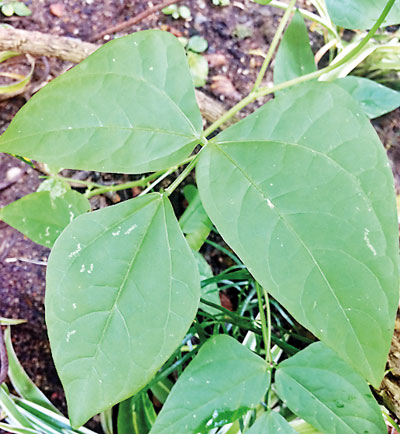
Cowpea
Cowpea, Vigna unguiculata in the family Leguminosae is a quick growing plant with twining stems varying in erectness and bushiness. Cowpea leaves are a good source of vitamins A and C. These vitamins help boost the immune system and act as antioxidants. The leaves also contain much higher levels of proteins, calories, calcium, iron and zinc than the seed. The plants are very easily grown by sowing the soaked seeds. Always use the softer leaves because they are tastier and easier to cook.
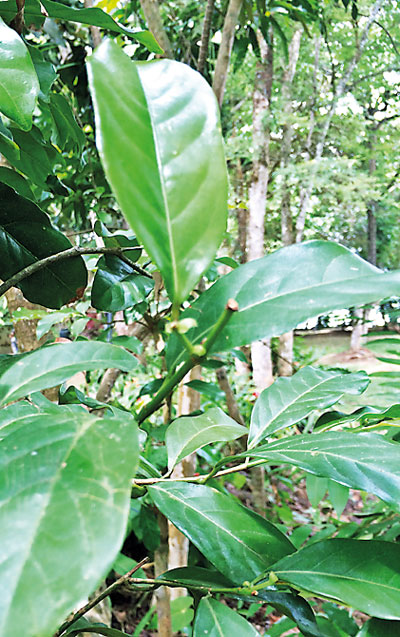 Kebella
Kebella
Kebella, Aporosa
lindleyana in the family Euphorbiaceae is an evergreen tree native to Sri Lanka wetlands. The leaves are simple and alternate and narrow oblong to narrow elliptic. Usually the leaves are immersed in hot water and then the water squeezed out prior to cooking. The leaves that have anti-infective and pain relieving properties are also used in a mixed mallung.
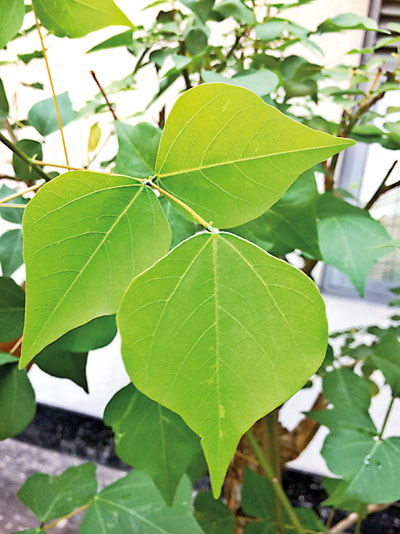 Erabudu
Erabudu
Erabudu, Erythrina variegata in the family Fabaceae is a showy spreading tree with brilliant blossoms and compound leaves with three diamond shaped leaflets. The leaves are commonly used as a vermicide for children to act against helminthes of which the most common forms are pinworms and tapeworms. Intestinal helminthes can cause a wide range of symptoms including diarrhoea, loss of appetite, stomach cramps etc. They are more common in children who usually contract these worms when they come into contact with contaminated earth, water, feces or food. Erabudu leaves are also known to help reduce body weight and stabilize cholesterol imbalance.It is important to use only very young light green leaves, as the mature leaves tend to be hard and stiff.
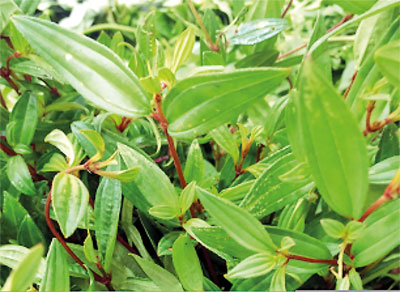
Heen bovitiya
Heen bovitiya, Osbeckia octandra in the family Melastomataceae, is a small evergreen tree that has dark green simple leaves with beautiful purple flowers. The plant is endemic to Sri Lanka and found close to streams, woodlands and forests in the wetlands of Sri Lanka. In traditional medicine the plant is used to treat jaundice and other liver disorders and as such is believed to be hepatoprotective that is it has the ability to prevent damage to the liver and is useful for fatty liver and all forms of hepatitis.
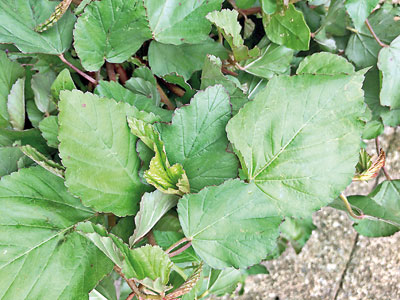 Gal kura
Gal kura
Gal kura, Melochia corchorifolia, chocolate weed in the family Sterculiaceae is a weedy, erect to spreading plant mostly found in slightly shaded, humid localities such as river banks and lake shores. Leaves are broadly ovate with an acutely serrate margin and arranged spirally on the stem which has a line of stellate hairs. The leaves contain several phytochemicals that include tri-terpenes and flavonoids and are used in the control of medical complications that include diabetes mellitus, urinary disorders, abdominal swelling, dysentery and intestinal bowel syndrome.
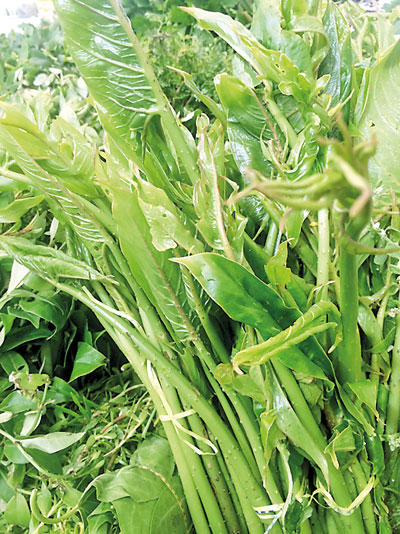 Kohila
Kohila
Kohila, Lasia spinosa in the family Araceae is a spinous herb which grows in Sri Lankan marshlands. It has a thorny pseudo-stem growing out of the ground ending in leaves which branch out like a hand. The tender-most leaves,kohila dalu, are the most delicious. Kohila is a dependable source of dietary fibre that has bowel regulating properties. Further, it reduces toxins in the intestines and is effective for other intestinal disorders. Kohila is also good for diabetic sufferers and those with high cholesterol because of its tendency to reduce absorption of sugar and fats.The leaves are rich in vitamins and minerals as well as iron, making it a complete package.
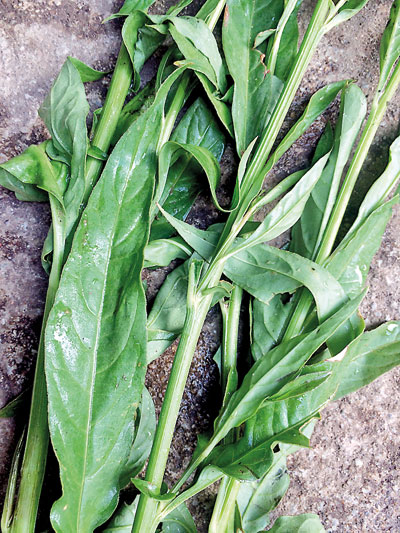
Kiri handa
Kiri handa, Celosia argentea in the family Amaranthaceae is commonly known as the silver cock’s comb. The nutritional content of the leaf is higher when the plant is young and before flowering. The leaves are still safe to eat once the celosia begins to flower, but they tend to become bitter and stringy. The leaves that contain high levels of beta-carotene and folic acid and medium levels of vitamins C and E, calcium and iron are also good in a stir fry. Celosia has long been known in its use for improving vision and curtailing various types of bleeding.
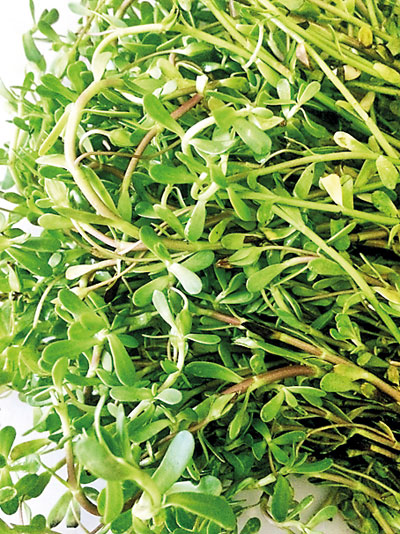
Lunuvila
Lunuvila, Bacopa monnieri in the family Plantaginaceae is a creeping herb that has small oval succulent leaves. The plant that thrives in muddy wetlands has been extensively tested and proven as a memory and concentration enhancer and has recently emerged as a super herb for the mind. Lunuvila also acts as a stress buster and mood elevator by decreasing the level of cortisol hormone, which is the main culprit for stress. The presence of antioxidants in the herb helps to dispel toxins from the body, especially from the epithelium layer thus improving skin complexion and stimulating skin cell regeneration.
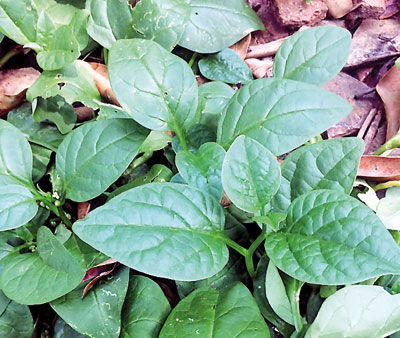
Nivithi
Nivithi, Basella alba or vine spinach in the family Basellaceae bears thick, fleshy, broad, oval to heart-shaped leaves all along its vine. Nivithi is a rich source of vitamins A and C and an excellent source of iron. Vitamin A is required for maintaining healthy mucus membranes and skin, and essential for good eye-sight while vitamin-C is a powerful antioxidant, which helps the body develop resistance against infectious agents. Iron is an important trace element required for red blood cell production. Nivithi also contains good amounts of B complex vitamins and minerals such as potassium, manganese, calcium, magnesium and copper.
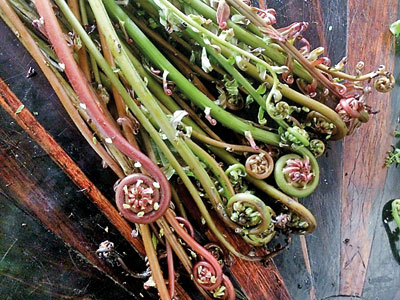
Karang koku
Karang koku, Acrostichum aureum in the family Pteridaceae also known as golden leather fern is a large species of ferns that grows in mangrove swamps and other wet locations.The tender leaves commonly called Karang koku are rich in dietary fibre and contain vitamins and minerals particularly iodine. The high dietary fibre improves overall gut health while slowing down the body’s breakdown of carbohydrates and the absorption of sugar, helping with blood sugar control and helps in lowering total blood cholesterol levels. Iodine is needed in the diet to maintain proper thyroid function and cell metabolism.
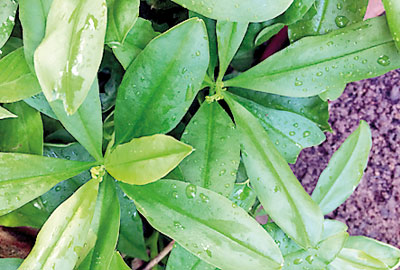
Surinam Nivithi
Surinam nivithi, Talinum triangulare, also called gas nivithi in the family Portulacaceae is sticky when cut, due to its high pectin content that supplies soluble dietary fibre. It is a rich source of vitamins C and E, omega3 fatty acids, calcium, magnesium, potassium, -carotene,and proteins. The leaves are also a good source of bioactive compounds that support the functioning of the liver and boosts overall well-being. Due to the high dietary fibre, it aids digestion preventing obesity and excess body weight. The leaves also support the regulation of cholesterol levels as well as help in managing blood sugar.
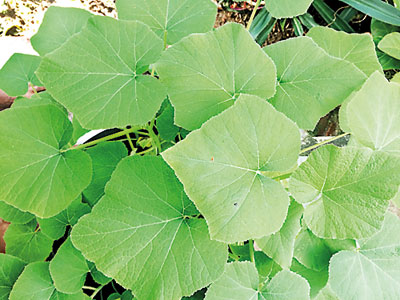 Wattakka
Wattakka
Wattakka, Cucurbita maxima in the family Cucurbitaceae is a vine with thick climbing or creeping stems with thin shallowly lobed leaves. The leaves like the fruits are a rich source of vitamin A and C. Vitamin A helps to maintain good sight and prevents diseases of the eye. Vitamin C, has anti-infective properties, promotes wound healing and a strong immune system. The leaves are also a significant source of calcium, potassium, phosphorus and magnesium which are necessary for growth and maintenance of the body. The leaves are good in a sambol or mallung as well.
Other leaves that can be used for curries are: Bathala, Genda, Gira pala, Gotukola, Knol kohl, Kankung, Leeks, Mukunuwenna, Neeramulliya, Rabu, Sarana, Tampala, Thumbe and Welpenela.


